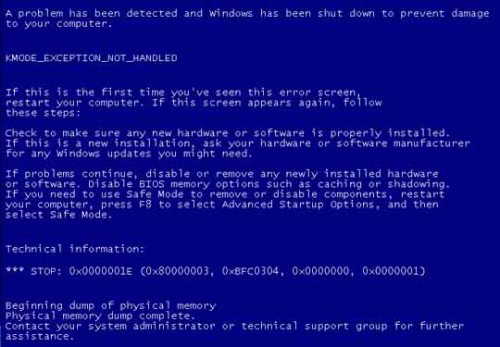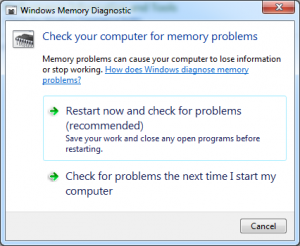-
-
products
-
resources
-
support
-
company
-
A Guide to the “KMode Exception Not Handled” Blue Screen of Death Error
By Steve Horton September 20, 2012Blue Screen of Death, bsod, KMODE_EXCEPTION_NOT_HANDLED5 CommentsThis article is part of a continuing series on Blue Screen of Death errors. A Blue Screen of Death (BSoD) is the error screen you see when Windows has a major issue. It halts the PC and displays some very important information.
Depending on the error message you get, the steps you need to take are different.
Error Name:
KMODE_EXCEPTION_NOT_HANDLED
KMODE_EXCEPTION_NOT_HANDLED means you’re having driver issues. Some piece of internal or external hardware connected to your PC is causing a driver conflict or error, which is causing your PC to crash.
Sometimes the additional information on your Blue Screen will list the specific driver causing the problem, but this isn’t always the case.
If it does list the driver, you’re going to want to disable it. If it doesn’t list it, read below.
Disabling a specific driver is tricky, but here’s how you do it.
Disable the Problem Driver
To track down the specific problem driver, you’ll need to run Driver Verifier, an application included with Windows.
- Click Start
- Type verifier in the box and press Enter
- Select Create Standard Settings, then click Next, then select Automatically Select all Drivers Installed on this Computer
- Click Next, then Finish
- Reboot your computer, and you will see the list of drivers to be verified during startup. If there is a faulty driver you will get a BSOD with its respective error message
- When you have determined the faulty driver, log back into Windows and you can uninstall the driver via the Device Manager (see below)
- Click Start and type verifier /reset
You can then identify the driver listed and uninstall it when you log back into Windows
Next, you will want to disable the Driver Verification so it doesn’t always check on startup.
To disable a driver once you’ve identified it:
- Restart your PC in Safe Mode in order to avoid any further Blue Screens of Death while you’re trying to take care of the problem
- Click Start
- Click Control Panel
- Click Device Manager
- Click the arrow next to individual devices, right click on the device, and click Properties
- click Details to see the driver name. If you see any devices with a yellow exclamation mark, you’re on the right track, but this will not necessarily be the case
- Additionally, try doing a CTRL + F on the Windows desktop for the driver name to see what folder it’s in; this will provide a clue as to what device the driver belongs to
- Once you find the offending driver, click Uninstall from that same Properties screen
- Windows will attempt to reinstall the driver itself from information it provides from the Internet. This is called Plug and Play. Allow it to do so
- Run Driver Reviver to update the new driver to the most recent version
Run Driver Reviver
Alternatively, run Driver Reviver first, and see if updating your drivers to the latest version takes care of the problem.
Hardware Incompatibility
Sometimes, this error will occur when you attempt to use hardware on a version of Windows that does not support it. If you just installed a new piece of hardware before getting the error, try Googling the model number of the hardware and the version of Windows you’re using (such as Windows XP) to see if there are known compatibility issues. Often, someone will have a workaround posted as well, which will allow you to use your device error-free.
BIOS or Memory Issue
This error can also pop up when your BIOS needs updated. Every PC has a different procedure for updating the BIOS, so once you enter it, write down the BIOS manufacturer and version number. Restart Windows and Google them to determine the correct procedure for updating the BIOS to the latest version.
To run a memory test:
- Click Start
- Click Control Panel
- Type memory in the search box
- Click on Diagnose your Computer’s Memory Problems
- Save any open files, then click Restart Now and Check for Problems. Windows will run a memory test after restarting, and notify you of any errors it finds
- If you do find memory errors, you’re going to need to replace your RAM
More Information from Microsoft
Here’s a page on Microsoft’s website about this specific BSoD error. It’s pretty technical, but worth checking out if the above solutions don’t work.
Good luck!
Was this post helpful?YesNoFree Driver Updates
Update your drivers in less than 2 minutes to enjoy better PC performance - Free.
Free Driver Updates
Update your drivers in less than 2 minutes to enjoy better
PC performance - Free.
Didn't find your answer?Ask a question to our community of experts from around the world and receive an answer in no time at all.most relevant recent articles Pin It on Pinterest

